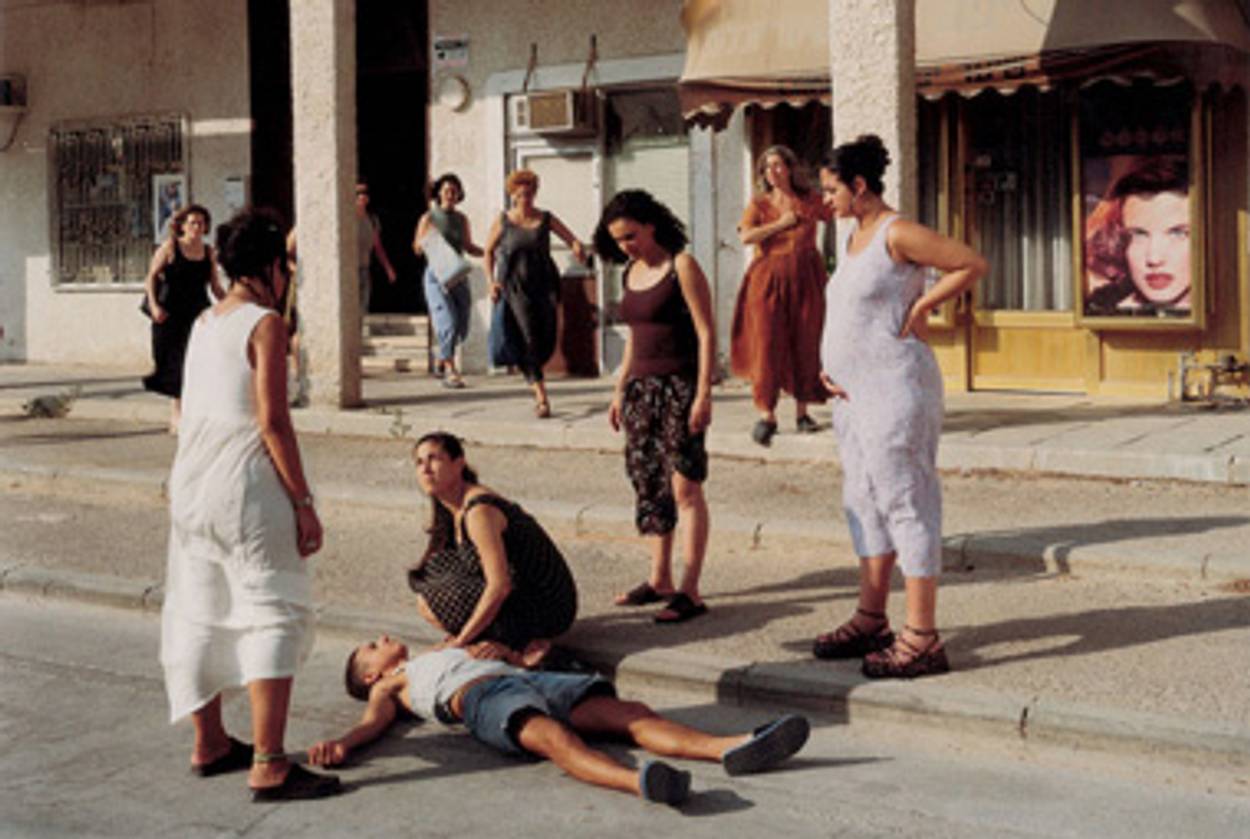Cross Pollination
How the figure of Jesus came to be employed in modern Jewish art




He thought it would be Good for the Jews. That’s what led Max Liebermann, assimilated German Jew and well-respected realist painter, to plot out a radical new take on a well-known passage from the Gospel of Saint Luke.
The scene, in which Joseph and Mary lose track of Jesus, only to find their precocious preadolescent debating with the elders in the Temple, had been depicted over the course of Western art history by everyone from Giotto to Fra Angelico to Rembrandt. Some, like the Italian Lodovico Mazzolino, signaled the Jewish setting through the interiors, showing a relief of Moses and Hebrew writing. Others, like Dürer, indulged in anti-Semitic caricature, treating each elder’s nose as a tour de force of grotesque.
Liebermann, though, went for naturalism. He based the architecture in his 1879 painting The 12-Year-Old Jesus in the Temple on sketches he had made in synagogues in Amsterdam and Venice. He clothed the elders—a mix of Orthodox and assimilated German Jews—in contemporary Jewish garb. And the youthful Jesus was also, clearly, a Jewish boy—and a ragged urchin with bare feet, to boot.
At a time when the idea of the Jewish Jesus was just taking hold in intellectual circles, Liebermann’s image of the savior as a ragamuffin came as a shock. When the painting debuted in Munich’s Second Annual International Art Exhibition of 1879, the Catholic clergy complained. The prince regent himself demanded it be moved to a less prominent location. Months later, the charges of blasphemy, tinged with anti-Semitism, were still going strong, surfacing in a debate in Parliament.
Liebermann responded by repainting Jesus in an Italianate style suitable for German tastes, with Gentile features, golden tresses, and immaculate historical robes. That is the image we see today in the painting, which was eventually acquired by the Hamburger Kunsthalle—twice. The museum explains why in “The Jesus Scandal,” an inventive exhibition marking the 75th anniversary of the artist’s death that recounts the genesis, reception, repainting, and subsequent peregrinations of Liebermann’s artwork. It includes preparatory sketches, works on the theme by such other artists as Rembrandt and Menzel, and documentation of the scandal at the Munich exhibition.
The exhibition’s final section shows what happened next. A few years after the scandal, Liebermann traded the work to artist Fritz von Uhde. It was exhibited several times, changed hands, and was acquired by the Kunsthalle in 1911. There it resided until 1941, when, because it did not conform to National Socialist criteria, the museum traded it to a dealer for more politically correct art. Years later, museum staff tracked the picture down. And in 1989, they finally reacquired it.
That picture, along with paintings by the Galician-born artist Maurycy Gottlieb (see first slide below) and a sculpture by Russia’s Mark Antokolsky, are the earliest works in an audacious, fascinating subgenre: the Jewish Jesus. In the late 19th century, as Ziva Amishai-Maisels has amply documented, these depictions were intended as propaganda for the Jewish community, an effort to help combat anti-Semitism through art. By reminding Christians that Jesus was an upstanding, influential, and Jewish teacher, these artists hoped they could remind audiences that those who oppressed Jews were attacking their savior’s own kind.
During the Holocaust, Jesus again began to appear in Jewish art—not so often as a preacher this time, but on the cross, as a stand-in for all the victims. Marc Chagall, most famously and controversially, made a long series of tragic, visceral Jewish crucifixion scenes, including some that are still being discovered. Other Jewish artists, including Mané Katz, Louise Nevelson, Adoph Gottlieb, and the German-born Mexican immigrant Mathias Goeritz, also linked the crucifixion to what was happening in the camps. In the work of contemporary artists Helène Aylon and Adi Nes, Jewish Jesus is more ambiguous. No longer merely an innocent victim, he is pressed into a more critical reading of the Bible and Jewish history.
Last week, London’s Ben Uri Gallery took the Jewish appropriation of the crucifixion into new territory when it opened the show “Cross Purposes.” Subtitled “Shock and Contemplation in Images of the Crucifixion,” it is made up of 21 images by artists ranging from Eric Gill and Duncan Grant to Lee Miller and Tracey Emin. It also includes work by three Jews: Chagall, Michael Rothstein, and Emmanuel Levy.
Not everyone liked the idea of a Jewish museum doing a show on an image that’s caused so much violence toward Jews. “Cross Purposes” was received by some, Jews and well as Christians, with “various degrees of concern from puzzlement to outrage,” says David J. Glasser, the museum’s executive co-chair, who on opening night found himself on the street with Sir Norman Rosenthal, a well-known British curator, explaining the exhibition’s thesis to a perturbed crowd. “The concern and anger seem principally to be based on the presumption that we as a proud Jewish Museum of Art should not under any circumstances address the crucifixion in any manner at all.”
The intent, Glasser says, was to trace the evolution of crucifixion iconography from a sacred image to a “universal generic motif” used by artists of all faiths to express opinions on not only religious but also social and political issues. For Gilbert Spencer, for example, it was the labor movement; for Duncan Grant, gay rights. So, rather than Judaizing the crucifixion, the show is in a sense attempting to de-Christianize it.
The underlying impulse, though, seems to relate to Liebermann’s: that reclaiming the crucifixion could somehow be good for the Jews.
Robin Cembalest is executive editor of ARTnews.
Robin Cembalest is executive editor of ARTnews. She blogs at letmypeopleshow.com. Her Twitter feed is @rcembalest.
Robin Cembalest is executive editor ofARTnews. She blogs at letmypeopleshow.com. Her Twitter feed is @rcembalest.